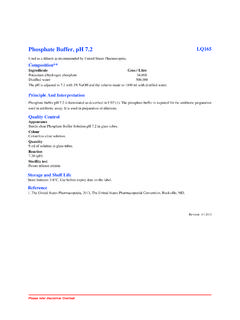Transcription of DBL™ POTASSIUM DIHYDROGEN PHOSPHATE …
1 Data Sheet New Zealand Version Page 1 DBL POTASSIUM DIHYDROGEN PHOSPHATE CONCENTRATED INJECTION NAME OF THE MEDICINE POTASSIUM PHOSPHATE monobasic ( POTASSIUM DIHYDROGEN PHOSPHATE ) DESCRIPTION The molecular formula of POTASSIUM PHOSPHATE monobasic is KH2PO4. Its molecular weight is The CAS Registry number of POTASSIUM PHOSPHATE monobasic is 7778-77-0. POTASSIUM PHOSPHATE monobasic is a white, odourless, granular or crystalline powder, or colourless crystals. It is freely soluble in water and practically insoluble in alcohol. DBL POTASSIUM DIHYDROGEN PHOSPHATE Concentrated Injection is a clear, colorless, sterile solution.
2 Each 10 mL ampoule contains g of POTASSIUM PHOSPHATE monobasic (KH2PO4) in Water for Injection. The pH of the solution is approximately Each mL of injection contains 1 mmol of POTASSIUM ions, 1 mmol of PHOSPHATE ions and 2 mmol of hydrogen ions. PHARMACOLOGY The majority (80%) of the body s PHOSPHATE is found as calcium PHOSPHATE in the skeleton, where it gives rigidity to the bone. The remainder is found in soft tissues. PHOSPHATE is the principle anion of intracellular fluid. In body fluids, PHOSPHATE is present mainly as divalent hydrogen PHOSPHATE (HPO42-) ions (approximately 80%) and monovalent DIHYDROGEN PHOSPHATE (H2PO4-) ions (approximately 20%).
3 Apart from its essential role in bone structure, PHOSPHATE is also important in many metabolic and enzymatic pathways. It is involved in energy storage and transfer, the utilization of B-complex vitamins, the buffering of body fluids, and in the renal excretion of hydrogen ions. Hypophosphataemia may arise from a variety of causes including primary hyperparathyroidism, Vitamin D deficiency, X-linked familial hypophosphataemia, alcoholism, hepatic failure and septicaemia. The symptoms of hypophosphataemia include muscle weakness, paraesthesia, convulsions, cardiomyopathy, respiratory failure and haematological abnormalities. Prolonged hypophosphataemia may result in rickets or osteomalacia.
4 Pharmacokinetics The normal concentration range of PHOSPHATE in plasma is to mmol/L. PHOSPHATE is primarily excreted in the urine. Over 90% of plasma PHOSPHATE is filtered in the kidneys with the majority being reabsorbed in the proximal tubule. Parathyroid hormone decreases the tubular reabsorption of PHOSPHATE , thereby increasing urinary excretion. In addition, serum PHOSPHATE levels are inversely related to serum calcium levels and to renal metabolism of Vitamin D. A decrease in serum calcium concentration will result in increased serum PHOSPHATE levels. INDICATIONS Treatment of severe hypophosphataemia (serum levels less than mmol/L) and other degrees of hypophosphataemia when oral therapy is not possible.
5 The cause of hypophosphataemia should be identified and treated. Data Sheet New Zealand Version Page 2 CONTRAINDICATIONS PHOSPHATE administration is contraindicated in patients with severe renal function impairment (less than 30% normal) since there is an increased risk of hyperphosphataemia in these patients. PHOSPHATE administration is contraindicated in patients with hyperphosphataemia, since PHOSPHATE therapy will exacerbate the condition. PHOSPHATE administration is contraindicated in patients with hypocalcaemia due to the close relationship between hypocalcaemia and hyperphosphataemia. DBL POTASSIUM DIHYDROGEN PHOSPHATE Concentrated Injection is contraindicated in patients with hyperkalaemia, since the POTASSIUM in the injection may exacerbate the condition.
6 DBL POTASSIUM DIHYDROGEN PHOSPHATE Concentrated Injection is contraindicated in Addison s disease since there is an increased risk of hyperkalaemia in these patients. PHOSPHATE administration is contraindicated in urolithiasis (magnesium ammonium PHOSPHATE type, infected) since it may exacerbate the condition. PRECAUTIONS PHOSPHATE should be administered with caution in conditions where high PHOSPHATE levels may be encountered, such as hypoparathyroidism, chronic renal disease, and rhabdomyolysis. PHOSPHATE should be administered with caution in conditions where low calcium levels may be encountered, such as hypoparathyroidism, osteomalacia, chronic renal disease, acute pancreatitis, rhabdomyolysis and rickets.
7 DBL POTASSIUM DIHYDROGEN PHOSPHATE Concentrated Injection should be administered with caution in conditions where high POTASSIUM levels may be encountered, such as acute dehydration, pancreatitis, rhabdomyolysis, severe renal insufficiency and extensive tissue damage (such as severe burns). DBL POTASSIUM DIHYDROGEN PHOSPHATE Concentrated Injection should be administered with caution in patients with myotonia congenita, and heart disease (particularly in digitalised patients) (see Interactions with other medicines) since these conditions may be exacerbated by the POTASSIUM in the injection. Effects on laboratory tests Saturation of bone binding sites by PHOSPHATE ions may cause decreased bone uptake of tecnetium Tc99m labelled contrast agents in bone imaging.
8 Use in pregnancy Animal reproduction studies have not been conducted with this product. It is not known whether this product can adversely effect the foetus when administered to a pregnant woman. Therefore DBL POTASSIUM DIHYDROGEN PHOSPHATE Concentrated Injection is not recommended for use during pregnancy. Use in lactation It is not known whether phosphates are excreted into breast milk, therefore DBL POTASSIUM DIHYDROGEN PHOSPHATE Concentrated Injection is not recommended for use during lactation. Data Sheet New Zealand Version Page 3 Interactions with other medicines Angiotensin converting enzyme (ACE) inhibitors: Concurrent use with DBL POTASSIUM DIHYDROGEN PHOSPHATE Concentrated Injection may result in hyperkalaemia, especially in patients with renal impairment.
9 Calcium containing medicines: Concurrent use of DBL POTASSIUM DIHYDROGEN PHOSPHATE Concentrated Injection and calcium containing medicines may increase the risk of deposition of calcium in soft tissues. Digitalis glycosides: The administration of DBL POTASSIUM DIHYDROGEN PHOSPHATE Concentrated Injection in digitalised patients with severe or complete heart block may result in hyperkalaemia. Diuretics, POTASSIUM sparing: Concurrent use with DBL POTASSIUM DIHYDROGEN PHOSPHATE Concentrated Injection may result in hyperkalaemia, especially in patients with renal impairment. Non-steroidal antiinflammatory agents (NSAIDS): Concurrent use with DBL POTASSIUM DIHYDROGEN PHOSPHATE Concentrated Injection may result in hyperkalaemia, especially in patients with renal impairment.
10 Other PHOSPHATE containing medicines: Concurrent use with DBL POTASSIUM DIHYDROGEN PHOSPHATE Concentrated Injection may result in hyperphosphataemia, especially in patients with impaired renal function. POTASSIUM containing medicines: Concurrent use with DBL POTASSIUM DIHYDROGEN PHOSPHATE Concentrated Injection may result in hyperkalaemia, especially in patients with renal impairment. Salicylates: Concurrent use with DBL POTASSIUM DIHYDROGEN PHOSPHATE Concentrated Injection may increase the serum concentration of salicylates, since salicylate excretion is decreased in acidified urine. This may result in toxic salicylate concentrations when PHOSPHATE is administered to patients already stabilized on salicylates.















